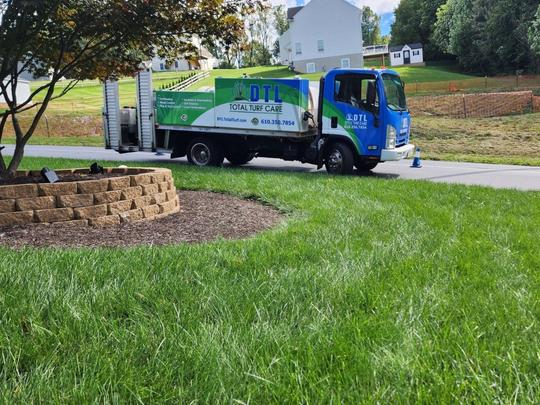Lawn restoration gained popularity in some Chester County areas, correcting neglect or inappropriate lawn care or landscaping practices. The process is like pressing a reset button and starting a new lawn.
Start fresh on a brand new canvas. What an attractive idea, isn’t it?
Now, pressing that restart button is not always necessary and the solution to all lawn issues. To be fair, it depends on how bad things really are. Sometimes, healthy lawn care practices and the relentless effort of following best practices can help improve turf over time. Hence, why deploy a drastic measure like a lawn restoration process?
If things look terrible and beyond a point of no return, some situations may require a complete lawn restoration. But, as always with lawn care, you will need to plan and follow some steps carefully. Read on.
Your Lawn Restoration Starting Point
Your lawn restoration process starts with the first step that kills your old, deteriorated lawn. The best time to do this is to start at the end of August through September, when temperatures slowly go down.
You will need to use a non-selective herbicide to do the job. The reason for this non-selective herbicide is that you need to kill all species that compose your lawn, even the last healthy turf spots.
The non-selective herbicide application is a delicate task that requires a thorough understanding of the manufacturer’s guidelines, a precise calculation of the surface, and careful consideration if you have shrubs and flower beds.
Once the non-selective herbicide has been carefully applied, you will see all species will die at different rates. It will take a few days to kill all species in your yard, and you may have to spot-spray a second time in the remaining areas where you can still see plants.
Clean Your Yard and Improve The Soil
Once all plants have died, do not overseed the new turf immediately. It would be a costly mistake. There are two steps you need to take in the lawn restoration process before overseeding:
- Clean your yard
- Improve the soil
Let’s start with yard cleaning.
It is time to remove debris and dead plants on the surface of your yard. You can use your lawn mower and a dethatcher. Although it sounds silly to mow a dead lawn, you remove the dead plants, mini branches, and miscellaneous debris with it. Then, use a dethatcher in several directions until the thatch has been completely removed. After that, use your rake to remove the thatch manually, bag it and remove it from your yard.
Once that step is completed, care about your soil condition; the best way to do it is to perform a soil analysis. Although we spoke extensively about soil analysis in previous blogs, let’s come back briefly to the principle of soil analysis.
Soil analysis determines the content of nutrients; nitrogen, phosphorus, potassium, pH, humus content, available lime, organic matter, total sulfur, sodium, and micro-nutrients. Based on the results you get from the lab, you can identify your soil deficiencies and work to improve their profile with soil amendments like lime or conditioners. Once you have completed that step, you can move on to the next one.
Aerate, Seed, and Care
Lawn aeration is one of the pillars of lawn care, and it is a simple mechanical process where plugs of soil are removed from the yard.
The principle of lawn aeration is to punch holes in the ground, and the goal is to alleviate soil compaction. We have covered that process extensively in a previous article that we recommend reading.
To punch these holes, the lawn care technician uses a piece of special equipment called a “core aerator” – a machine specifically designed to remove plugs of soil.
Once the soil is aerated, we recommend planting Blue-Tag Certified seeds. These specific seeds have the highest purity and germination standards, and usually, these seeds have the lowest weed content. To spread these seeds, use a spreader, sow one-half the seed lengthwise, and then go for one-half crosswise to avoid skips. Let the seed germinate and establish a root system.
Now, here are some essential points you should consider:
- Soils are warmer during late August and early September
- Slightly moist soils are easier to prepare for seeding than wet soils
- Warmer soils facilitate better germination and establishment
Remember that if you plant your Bue Tag seeds in late summer, they will have fall and spring to grow to establish themselves.
If you seed during spring, your plants will be subject to summer heat and drought, which can cause issues. Also, weeds are usually more of a problem in spring than in late summer.
Your last step will be to apply a starter fertilizer just after seeding. Your starter fertilizer will provide sufficient and necessary nutrients to your new seedlings to ensure a good and satisfactory establishment.
Make sure to follow up after 4 to 6 weeks. Most lawn establishments fail because the homeowner forgets that follow-up care is essential to a healthy plant establishment.
As the newly-established lawn grows, do not forget to water and mow it, and add fertilizers on a routine basis respecting best lawn care practices – not too much water and not cutting too short.
Finally, avoid human or pet traffic on your newly established lawn.
Your Takeaways
There are many different aspects to consider when preparing for a lawn restoration. The success of a lawn restoration depends on preparation, approach, and consistent follow-up. We highly recommend establishing a lawn restoration plan before engaging in this tedious process.
If you follow the steps described in our article and reach the point of working on plant establishment, consider the best lawn care practices because a successful establishment lasts for years. As always, if you need help, contact our team at DTL Total Turf Care.

